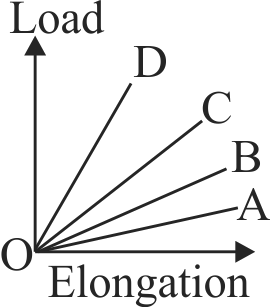369785 Two wires are made of the same material and have the same volume. However wire 1 has cross-sectional area \(A\) and wire 2 has cross-sectional area \(9\;A\). If the length of wire 1 increases by \(\Delta x\) on applying force \(F\), how much force is needed to stretch wire 2 by the same amount?
369787 Two wires of different materials have same length \(\mathrm{L}\) and same diameter \(\mathrm{d}\). The second wire is connected at the end of the first wire and forms one single wire of double the length. This wire is subjected to streching force \(\mathrm{F}\) to produce the elongation \(l\). The two wires have
369785 Two wires are made of the same material and have the same volume. However wire 1 has cross-sectional area \(A\) and wire 2 has cross-sectional area \(9\;A\). If the length of wire 1 increases by \(\Delta x\) on applying force \(F\), how much force is needed to stretch wire 2 by the same amount?
369787 Two wires of different materials have same length \(\mathrm{L}\) and same diameter \(\mathrm{d}\). The second wire is connected at the end of the first wire and forms one single wire of double the length. This wire is subjected to streching force \(\mathrm{F}\) to produce the elongation \(l\). The two wires have
369785 Two wires are made of the same material and have the same volume. However wire 1 has cross-sectional area \(A\) and wire 2 has cross-sectional area \(9\;A\). If the length of wire 1 increases by \(\Delta x\) on applying force \(F\), how much force is needed to stretch wire 2 by the same amount?
369787 Two wires of different materials have same length \(\mathrm{L}\) and same diameter \(\mathrm{d}\). The second wire is connected at the end of the first wire and forms one single wire of double the length. This wire is subjected to streching force \(\mathrm{F}\) to produce the elongation \(l\). The two wires have
369785 Two wires are made of the same material and have the same volume. However wire 1 has cross-sectional area \(A\) and wire 2 has cross-sectional area \(9\;A\). If the length of wire 1 increases by \(\Delta x\) on applying force \(F\), how much force is needed to stretch wire 2 by the same amount?
369787 Two wires of different materials have same length \(\mathrm{L}\) and same diameter \(\mathrm{d}\). The second wire is connected at the end of the first wire and forms one single wire of double the length. This wire is subjected to streching force \(\mathrm{F}\) to produce the elongation \(l\). The two wires have

